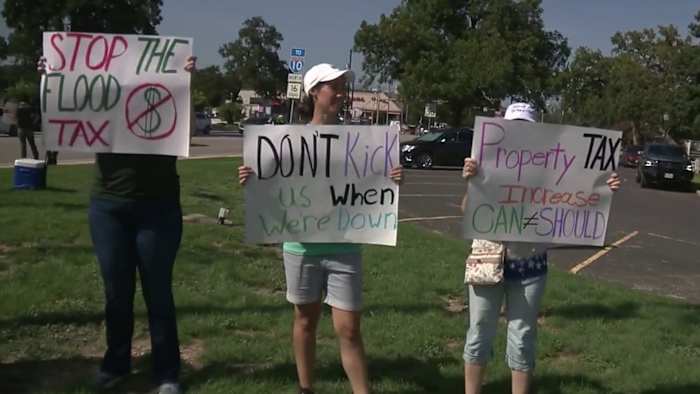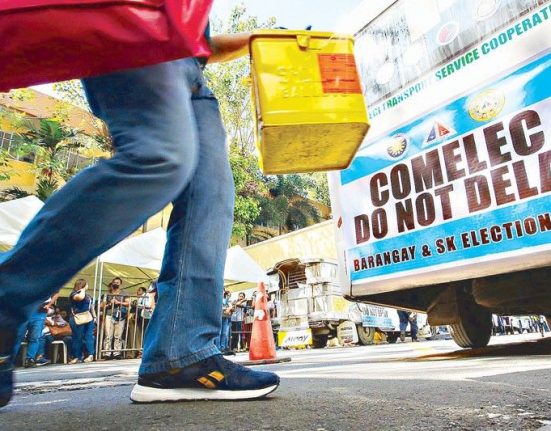KERRVILLE, Texas – With signs in hand, protesters stood along Sidney Baker Street in Kerrville on Wednesday, calling for clarity from Kerr County.
“There are families that are grieving and will be grieving for months,” organizer Sunny Hall said. “It’s absolutely disgusting (the Kerr County Commissioners’ Court is) even talking about it right now.”
The demonstration was in response to a county meeting held earlier this week.
The Kerr County Commissioners’ Court, which represents 53,166 people in central Texas, discussed their options under the Texas Property Tax Code.
The commissioners have not approved a tax rate increase, but they did begin laying groundwork for considering it later this year.
How can Kerr County raise taxes without voter approval?
On Monday, the Kerr County Commissioners’ Court unanimously approved Tax Assessor-Collector Bob Reeves to calculate an adjusted “voter-approval tax rate” for the county as well as the Lateral Roads and Lake Ingram Estates districts.
The voter-approval tax rate is the maximum a single governing body can raise taxes without receiving voter approval under state law. It is not the actual tax rate charged to residents.
For example, the voter-approval tax rate for 2024 in Kerr County was 47.72 cents per $100 of assessed property value. But leaders chose to adopt a lower property tax rate of 40.11 cents per $100 of assessed property value.
Using a formula provided by the Texas Property Tax Code, governments calculate a new voter-approval tax rate each year.
Typically, the voter-approval tax rate is calculated by multiplying the tax rate needed to maintain operations, without new revenue, by 3.5%. Then, adding the current debt rate and unused increment rates.
Over the last two years, the voter-approval tax rate in Kerr County rose around 2.5% per year.
Why are leaders talking about raising taxes now?
Section 26.042 of the Texas property tax code allows local governments to use a special formula to calculate the voter-approval tax rate if any part of the taxing district is in a disaster area declared by the president or governor.
The special formula replaces the percentage being multiplied from 3.5% to 8%, and removes the need to add the unused increment rate to the formula.
Assessor-Collector Reeves said he will calculate the voter-approval tax rate using both formulas, but could not do so without the commissioners’ court’s approval on Monday.
Reeves said that he would bring both calculations to the next meeting, currently scheduled for July 28.
Using the calculations, commissioners will determine the actual property tax rate. Kerr County Judge Rob Kelly said the calculations must be completed now because time is running out to finalize next year’s budget.
“Our whole budget period is being eroded away,” Kelly said Monday.
Once approved, the tax rate will become effective at the beginning of the tax year on October 1.
The decision could be made in September.
Federal, state officials said they are paying for recovery efforts. Why does the county need additional money?
Kelly said that the last time the county dealt with the Federal Emergency Management Agency (FEMA), it took two to three years before the county was reimbursed for recovery efforts.
“It’s more cash flow management,” Kelly said Monday. “We’re going to have to pay for this stuff. A lot of this is going to be reimbursed by FEMA … but, they’re slow.”
In the meantime, he said the county will be responsible for paying contractors, and must have the cash to be able to do so.
KSAT 12 reached out to commissioners for comment on Wednesday and have not heard back. A summary about the tax discussion was posted to the county’s website, though.
The tax code, however, provides relief to taxpayers once the extra funds are received. In other words, county commissioners could eventually use the FEMA money to lower property taxes if they choose.
After either three years under the disaster formula or when the tax base increases after the disaster, tax assessors use the emergency revenue rate for one year to provide relief to taxpayers for the increased taxes.
“The difference is not to pad a budget or anything like that,” Assessor-Collector Reeves said.
More coverage of this story on KSAT:
Copyright 2025 by KSAT – All rights reserved.







